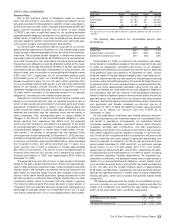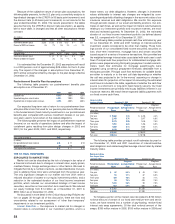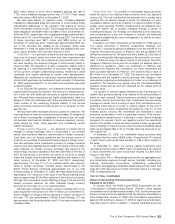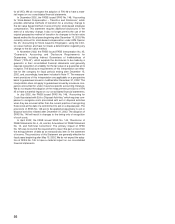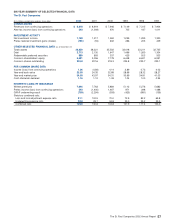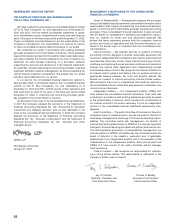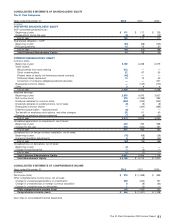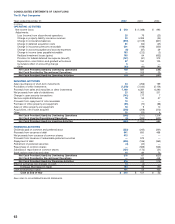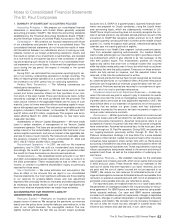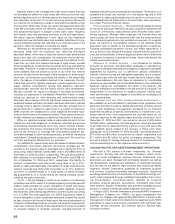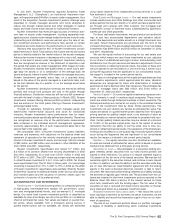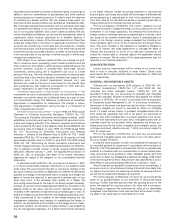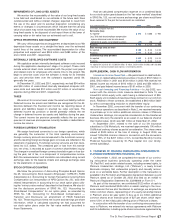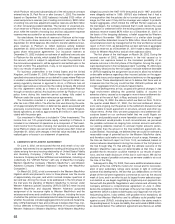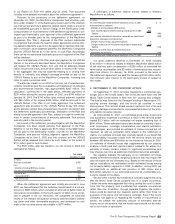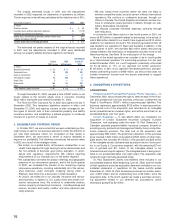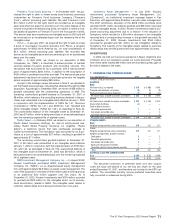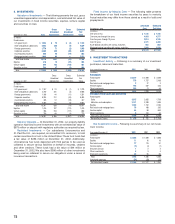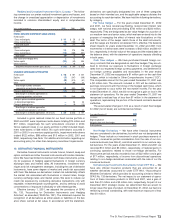Travelers 2002 Annual Report Download - page 65
Download and view the complete annual report
Please find page 65 of the 2002 Travelers annual report below. You can navigate through the pages in the report by either clicking on the pages listed below, or by using the keyword search tool below to find specific information within the annual report.
1. SUMMARY OF SIGNIFICANT ACCOUNTING POLICIES
Accounting Principles — We prepare our consolidated financial
statements in accordance with United States generally accepted
accounting principles (“GAAP”). We follow the accounting standards
established by the Financial Accounting Standards Board (“FASB”)
and the American Institute of Certified Public Accountants (“AICPA”).
Consolidation — We combine our financial statements with those
of our subsidiaries and present them on a consolidated basis. The
consolidated financial statements do not include the results of mate-
rial transactions between our subsidiaries and us or among our sub-
sidiaries. Certain of our foreign underwriting operations’ results, and
the results of certain of our investments in partnerships, are recorded
on a one-month to one-quarter lag due to time constraints in obtain-
ing and analyzing such results for inclusion in our consolidated finan-
cial statements on a current basis. In the event that significant events
occur during the lag period, the impact is included in the current
period results.
During 2001, we eliminated the one-quarter reporting lag for cer-
tain of our primary underwriting operations in foreign countries. The
effect of reporting these operations on a current basis was a $31 mil-
lion increase to our 2001 pretax loss on continuing operations.
Related Party Transactions — The following summarizes our
related party transactions:
Indebtedness of Management — We have made loans to certain
current and former executive officers for their purchase of our com-
mon stock in the open market. These are full-recourse loans, further
secured by a pledge of the stock purchased with the proceeds. The
loans accrue interest at the applicable federal rate for loans of such
maturity. Loans to former executive officers are being repaid in accor-
dance with agreed-upon terms.The total amount receivable under this
program, included in “Other Assets”, on December 31, 2002 and 2001
was $7 million and $10 million, respectively. This program was termi-
nated effective March 20, 2002; consequently, no new loans were
made after that date.
Indebtedness of Venture Capital Management — We have made
loans to certain members of management of our Venture Capital
investment operation.The loans are secured by each individual’s own-
ership interest in the limited liability companies that hold most of our
venture capital investments, and accrue interest at the applicable fed-
eral rate for loans of such maturity.The total amount receivable under
this program, included in “Other Assets” at December 31, 2002 and
2001, was $7 million and $6 million, respectively.
Discontinued Operations — In 2001, we sold our life insurance
operations, and in 2000, we sold our nonstandard auto business.
Accordingly, the results of operations for all years presented reflect
the results for these businesses as discontinued operations.
Reclassifications — We reclassified certain amounts in our 2001
and 2000 consolidated financial statements and notes to conform to
the 2002 presentation. These reclassifications had no effect on net
income, or common or preferred shareholders’ equity, as previously
reported for those years.
Use of Estimates — We make estimates and assumptions that
have an effect on the amounts that we report in our consolidated
financial statements. Our most significant estimates are those relating
to our reserves for property-liability losses and loss adjustment
expenses.We continually review our estimates and make adjustments
as necessary, but actual results could turn out to be significantly dif-
ferent from what we expected when we made these estimates.
ACCOUNTING FOR OUR PROPERTY-LIABILITY
UNDERWRITING OPERATIONS
Premiums Earned — Premiums on insurance policies are our
largest source of revenue. We recognize the premiums as revenues
evenly over the policy terms using the daily pro rata method or, in the
case of our Lloyd’s business, the one-eighths method. The one-
eighths method reflects the fact that we convert Lloyd’s syndicate
The St. Paul Companies 2002 Annual Report 63
accounts to U.S. GAAP on a quarterly basis. Quarterly financial state-
ments are prepared for Lloyd’s syndicates, using the Lloyd’s three-
year accounting basis, which are subsequently converted to U.S.
GAAP. Since Lloyd’s accounting does not currently recognize the con-
cept of earned premium, we calculate earned premium as part of the
conversion to GAAP. We recognize written premium for U.S. GAAP
purposes quarterly, and assume that it is written at the middle of each
quarter (i.e., evenly throughout each period), effectively breaking the
calendar year into earning periods of eighths.
Revenues in our Health Care segment include premiums gener-
ated from extended reporting endorsements. Our medical liability
claims-made policies give our insureds the right to purchase a report-
ing endorsement, which is also referred to as “tail coverage,” at the
time their policies expire. This endorsement protects an insured
against any claims that arise from a medical incident that occurred
while the claims-made policy was in force, but which had not yet been
reported by the time the policy expired. Premiums on these endorse-
ments are fully earned as revenue, and the expected losses are
reserved, at the time the endorsement is written.
We record premiums that we have not yet recognized as revenues
as unearned premiums on our balance sheet. Assumed reinsurance
premiums are recognized as revenues proportionately over the con-
tract period. Premiums earned are recorded in our statement of oper-
ations, net of our cost to purchase reinsurance.
Insurance Losses and Loss Adjustment Expenses — Losses rep-
resent the amounts we paid or expect to pay to claimants for events
that have occurred.The costs of investigating, resolving and process-
ing these claims are known as loss adjustment expenses (“LAE”).We
record these items on our statement of operations net of reinsurance,
meaning that we reduce our gross losses and loss adjustment
expenses incurred by the amounts we have recovered or expect to
recover under reinsurance contracts.
Reinsurance — Written premiums, earned premiums and incurred
insurance losses and LAE all reflect the net effects of assumed and
ceded reinsurance transactions. Assumed reinsurance refers to our
acceptance of certain insurance risks that other insurance companies
have underwritten. Assumed reinsurance has, for the most part, been
written through our St. Paul Re operation.During 2002, we transferred
our ongoing business previously written through St. Paul Re to
Platinum Underwriters Holdings, Ltd. See Note 2 for a more detailed
discussion of this transfer. Ceded reinsurance means other insurance
companies have agreed to share certain risks with us. Reinsurance
accounting is followed for assumed and ceded transactions when risk
transfer requirements have been met.These requirements involve sig-
nificant assumptions being made related to the amount and timing of
expected cash flows, as well as the interpretation of underlying con-
tract terms.
Insurance Reserves — We establish reserves for the estimated
total unpaid cost of losses and LAE, which cover events that occurred
in 2002 and prior years. These reserves reflect our estimates of the
total cost of claims that were reported to us (“case” reserves), but not
yet paid, and the cost of claims incurred but not yet reported to us
(“IBNR”). We reduce our loss reserves for estimated amounts of sal-
vage and subrogation recoveries. Estimated amounts recoverable from
reinsurers on paid and unpaid losses and LAE, net of an allowance for
estimated unrecoverable amounts, are reflected as assets.
For reported losses, we establish reserves on a “case” basis within
the parameters of coverage provided in the insurance policy or reinsur-
ance agreement. For IBNR losses, we estimate reserves using estab-
lished actuarial methods. Our case and IBNR reserve estimates
consider such variables as past loss experience, changes in legislative
conditions, changes in judicial interpretation of legal liability and policy
coverages, and inflation. We consider not only monetary increases in
the cost of what we insure, but also changes in societal factors that
influence jury verdicts and case law and, in turn, claim costs.
Notes to Consolidated Financial Statements
The St. Paul Companies


